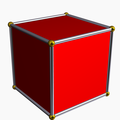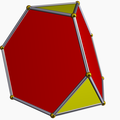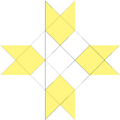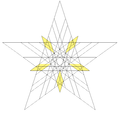| Index | Name | Picture | Dual name | Dual picture | Wythoff symbol | Vertex figure | Symmetry group | U# | K# | V | E | F | Faces by type |
|---|
| 67 | Tetrahemihexahedron |  | Tetrahemihexacron |  | 3/23|2 | 
4.3/2.4.3 | Td | U04 | K09 | 6 | 12 | 7 | 4{3}+3{4} |
| 68 | Octahemioctahedron |  | Octahemioctacron |  | 3/23|3 | 
6.3/2.6.3 | Oh | U03 | K08 | 12 | 24 | 12 | 8{3}+4{6} |
| 69 | Small cubicuboctahedron |  | Small hexacronic icositetrahedron |  | 3/24|4 | 
8.3/2.8.4 | Oh | U13 | K18 | 24 | 48 | 20 | 8{3}+6{4}+6{8} |
| 70 | Small ditrigonal icosidodecahedron |  | Small triambic icosahedron |  | 3|5/23 | 
(5/2.3)3 | Ih | U30 | K35 | 20 | 60 | 32 | 20{3}+12{5/2} |
| 71 | Small icosicosidodecahedron |  | Small icosacronic hexecontahedron |  | 5/23|3 | 
6.5/2.6.3 | Ih | U31 | K36 | 60 | 120 | 52 | 20{3}+12{5/2}+20{6} |
| 72 | Small dodecicosidodecahedron |  | Small dodecacronic hexecontahedron |  | 3/25|5 | 
10.3/2.10.5 | Ih | U33 | K38 | 60 | 120 | 44 | 20{3}+12{5}+12{10} |
| 73 | Dodecadodecahedron |  | Medial rhombic triacontahedron |  | 2|5/25 | 
(5/2.5)2 | Ih | U36 | K41 | 30 | 60 | 24 | 12{5}+12{5/2} |
| 74 | Small rhombidodecahedron |  | Small rhombidodecacron |  | 25/25| | 
10.4.10/9.4/3 | Ih | U39 | K44 | 60 | 120 | 42 | 30{4}+12{10} |
| 75 | Truncated great dodecahedron |  | Small stellapentakis dodecahedron |  | 25/2|5 | 
10.10.5/2 | Ih | U37 | K42 | 60 | 90 | 24 | 12{5/2}+12{10} |
| 76 | Rhombidodecadodecahedron |  | Medial deltoidal hexecontahedron |  | 5/25|2 | 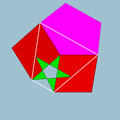
4.5/2.4.5 | Ih | U38 | K43 | 60 | 120 | 54 | 30{4}+12{5}+12{5/2} |
| 77 | Great cubicuboctahedron |  | Great hexacronic icositetrahedron |  | 3 4|4/3 | 
8/3.3.8/3.4 | Oh | U14 | K19 | 24 | 48 | 20 | 8{3}+6{4}+6{8/3} |
| 78 | Cubohemioctahedron |  | Hexahemioctacron |  | 4/34|3 | 
6.4/3.6.4 | Oh | U15 | K20 | 12 | 24 | 10 | 6{4}+4{6} |
| 79 | Cubitruncated cuboctahedron
(Cuboctatruncated cuboctahedron) |  | Tetradyakis hexahedron |  | 4/33 4| | 
8/3.6.8 | Oh | U16 | K21 | 48 | 72 | 20 | 8{6}+6{8}+6{8/3} |
| 80 | Ditrigonal dodecadodecahedron |  | Medial triambic icosahedron |  | 3|5/35 | 
(5/3.5)3 | Ih | U41 | K46 | 20 | 60 | 24 | 12{5}+12{5/2} |
| 81 | Great ditrigonal dodecicosidodecahedron |  | Great ditrigonal dodecacronic hexecontahedron |  | 3 5|5/3 | 
10/3.3.10/3.5 | Ih | U42 | K47 | 60 | 120 | 44 | 20{3}+12{5}+12{10/3} |
| 82 | Small ditrigonal dodecicosidodecahedron |  | Small ditrigonal dodecacronic hexecontahedron |  | 5/33|5 | 
10.5/3.10.3 | Ih | U43 | K48 | 60 | 120 | 44 | 20{3}+12{5/2}+12{10} |
| 83 | Icosidodecadodecahedron |  | Medial icosacronic hexecontahedron |  | 5/35|3 | 
6.5/3.6.5 | Ih | U44 | K49 | 60 | 120 | 44 | 12{5}+12{5/2}+20{6} |
| 84 | Icositruncated dodecadodecahedron
(Icosidodecatruncated icosidodecahedron) |  | Tridyakis icosahedron |  | 5/33 5| | 
10/3.6.10 | Ih | U45 | K50 | 120 | 180 | 44 | 20{6}+12{10}+12{10/3} |
| 85 | Nonconvex great rhombicuboctahedron
(Quasirhombicuboctahedron) |  | Great deltoidal icositetrahedron | 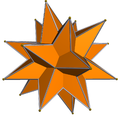 | 3/24|2 | 
4.3/2.4.4 | Oh | U17 | K22 | 24 | 48 | 26 | 8{3}+(6+12){4} |
| 86 | Small rhombihexahedron |  | Small rhombihexacron |  | 3/22 4| | 
4.8.4/3.8 | Oh | U18 | K23 | 24 | 48 | 18 | 12{4}+6{8} |
| 87 | Great ditrigonal icosidodecahedron |  | Great triambic icosahedron |  | 3/2|3 5 | 
(5.3.5.3.5.3)/2 | Ih | U47 | K52 | 20 | 60 | 32 | 20{3}+12{5} |
| 88 | Great icosicosidodecahedron |  | Great icosacronic hexecontahedron |  | 3/25|3 | 
6.3/2.6.5 | Ih | U48 | K53 | 60 | 120 | 52 | 20{3}+12{5}+20{6} |
| 89 | Small icosihemidodecahedron |  | Small icosihemidodecacron |  | 3/23|5 | 
10.3/2.10.3 | Ih | U49 | K54 | 30 | 60 | 26 | 20{3}+6{10} |
| 90 | Small dodecicosahedron |  | Small dodecicosacron |  | 3/23 5| | 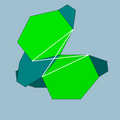
10.6.10/9.6/5 | Ih | U50 | K55 | 60 | 120 | 32 | 20{6}+12{10} |
| 91 | Small dodecahemidodecahedron |  | Small dodecahemidodecacron |  | 5/45|5 | 
10.5/4.10.5 | Ih | U51 | K56 | 30 | 60 | 18 | 12{5}+6{10} |
| 92 | Stellated truncated hexahedron
(Quasitruncated hexahedron) | 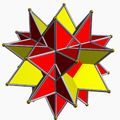 | Great triakis octahedron |  | 2 3|4/3 | 
8/3.8/3.3 | Oh | U19 | K24 | 24 | 36 | 14 | 8{3}+6{8/3} |
| 93 | Great truncated cuboctahedron
(Quasitruncated cuboctahedron) |  | Great disdyakis dodecahedron |  | 4/32 3| | 
8/3.4.6 | Oh | U20 | K25 | 48 | 72 | 26 | 12{4}+8{6}+6{8/3} |
| 94 | Great icosidodecahedron |  | Great rhombic triacontahedron |  | 2|5/23 | 
(5/2.3)2 | Ih | U54 | K59 | 30 | 60 | 32 | 20{3}+12{5/2} |
| 95 | Truncated great icosahedron |  | Great stellapentakis dodecahedron |  | 25/2|3 | 
6.6.5/2 | Ih | U55 | K60 | 60 | 90 | 32 | 12{5/2}+20{6} |
| 96 | Rhombicosahedron |  | Rhombicosacron |  | 25/23| | 
6.4.6/5.4/3 | Ih | U56 | K61 | 60 | 120 | 50 | 30{4}+20{6} |
| 97 | Small stellated truncated dodecahedron
(Quasitruncated small stellated dodecahedron) |  | Great pentakis dodecahedron |  | 2 5|5/3 | 
10/3.10/3.5 | Ih | U58 | K63 | 60 | 90 | 24 | 12{5}+12{10/3} |
| 98 | Truncated dodecadodecahedron
(Quasitruncated dodecahedron) |  | Medial disdyakis triacontahedron |  | 5/32 5| | 
10/3.4.10 | Ih | U59 | K64 | 120 | 180 | 54 | 30{4}+12{10}+12{10/3} |
| 99 | Great dodecicosidodecahedron |  | Great dodecacronic hexecontahedron |  | 5/23|5/3 | 
10/3.5/2.10/3.3 | Ih | U61 | K66 | 60 | 120 | 44 | 20{3}+12{5/2}+12{10/3} |
| 100 | Small dodecahemicosahedron |  | Small dodecahemicosacron |  | 5/35/2|3 | 
6.5/3.6.5/2 | Ih | U62 | K67 | 30 | 60 | 22 | 12{5/2}+10{6} |
| 101 | Great dodecicosahedron |  | Great dodecicosacron |  | 5/35/23| | 
6.10/3.6/5.10/7 | Ih | U63 | K68 | 60 | 120 | 32 | 20{6}+12{10/3} |
| 102 | Great dodecahemicosahedron |  | Great dodecahemicosacron |  | 5/45|3 | 
6.5/4.6.5 | Ih | U65 | K70 | 30 | 60 | 22 | 12{5}+10{6} |
| 103 | Great rhombihexahedron |  | Great rhombihexacron |  | 4/33/22| | 
4.8/3.4/3.8/5 | Oh | U21 | K26 | 24 | 48 | 18 | 12{4}+6{8/3} |
| 104 | Great stellated truncated dodecahedron
(Quasitruncated great stellated dodecahedron) |  | Great triakis icosahedron |  | 2 3|5/3 | 
10/3.10/3.3 | Ih | U66 | K71 | 60 | 90 | 32 | 20{3}+12{10/3} |
| 105 | Nonconvex great rhombicosidodecahedron
(Quasirhombicosidodecahedron) |  | Great deltoidal hexecontahedron |  | 5/33|2 | 
4.5/3.4.3 | Ih | U67 | K72 | 60 | 120 | 62 | 20{3}+30{4}+12{5/2} |
| 106 | Great icosihemidodecahedron |  | Great icosihemidodecacron |  | 3 3|5/3 | 
10/3.3/2.10/3.3 | Ih | U71 | K76 | 30 | 60 | 26 | 20{3}+6{10/3} |
| 107 | Great dodecahemidodecahedron |  | Great dodecahemidodecacron |  | 5/35/2|5/3 | 
10/3.5/3.10/3.5/2 | Ih | U70 | K75 | 30 | 60 | 18 | 12{5/2}+6{10/3} |
| 108 | Great truncated icosidodecahedron
(Great quasitruncated icosidodecahedron) |  | Great disdyakis triacontahedron |  | 5/32 3| | 
10/3.4.6 | Ih | U68 | K73 | 120 | 180 | 62 | 30{4}+20{6}+12{10/3} |
| 109 | Great rhombidodecahedron |  | Great rhombidodecacron |  | 3/25/32| | 
4.10/3.4/3.10/7 | Ih | U73 | K78 | 60 | 120 | 42 | 30{4}+12{10/3} |
| 110 | Small snub icosicosidodecahedron |  | Small hexagonal hexecontahedron |  | |5/23 3 | 
3.3.3.3.3.5/2 | Ih | U32 | K37 | 60 | 180 | 112 | (40+60){3}+12{5/2} |
| 111 | Snub dodecadodecahedron |  | Medial pentagonal hexecontahedron |  | |25/25 | 
3.3.5/2.3.5 | I | U40 | K45 | 60 | 150 | 84 | 60{3}+12{5}+12{5/2} |
| 112 | Snub icosidodecadodecahedron |  | Medial hexagonal hexecontahedron |  | |5/33 5 | 
3.3.3.3.5.5/3 | I | U46 | K51 | 60 | 180 | 104 | (20+6){3}+12{5}+12{5/2} |
| 113 | Great inverted snub icosidodecahedron |  | Great inverted pentagonal hexecontahedron | 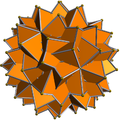 | |5/32 3 | 
3.3.3.3.5/3 | I | U69 | K74 | 60 | 150 | 92 | (20+60){3}+12{5/2} |
| 114 | Inverted snub dodecadodecahedron |  | Medial inverted pentagonal hexecontahedron |  | |5/32 5 | 
3.5/3.3.3.5 | I | U60 | K65 | 60 | 150 | 84 | 60{3}+12{5}+12{5/2} |
| 115 | Great snub dodecicosidodecahedron |  | Great hexagonal hexecontahedron |  | |5/35/23 | 
3.5/3.3.5/2.3.3 | I | U64 | K69 | 60 | 180 | 104 | (20+60){3}+(12+12){5/2} |
| 116 | Great snub icosidodecahedron |  | Great pentagonal hexecontahedron |  | |25/25/2 | 
3.3.3.3.5/2 | I | U57 | K62 | 60 | 150 | 92 | (20+60){3}+12{5/2} |
| 117 | Great retrosnub icosidodecahedron |  | Great pentagrammic hexecontahedron |  | |3/25/32 | 
(3.3.3.3.5/2)/2 | I | U74 | K79 | 60 | 150 | 92 | (20+60){3}+12{5/2} |
| 118 | Small retrosnub icosicosidodecahedron |  | Small hexagrammic hexecontahedron |  | |3/23/25/2 | 
(3.3.3.3.3.5/2)/2 | Ih | U72 | K77 | 180 | 60 | 112 | (40+60){3}+12{5/2} |
| 119 | Great dirhombicosidodecahedron |  | Great dirhombicosidodecacron |  | |3/25/335/2 | 
(4.5/3.4.3.4.5/2.4.3/2)/2 | Ih | U75 | K80 | 60 | 240 | 124 | 40{3}+60{4}+24{5/2} |




